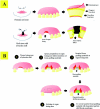Mimicked Periosteum Layer Based on Deposited Particle Silk Fibroin Membrane for Osteogenesis and Guided Bone Regeneration in Alveolar Cleft Surgery: Formation and in Vitro Testing
- PMID: 34719332
- PMCID: PMC9208804
- DOI: 10.1080/15476278.2021.1991743
Mimicked Periosteum Layer Based on Deposited Particle Silk Fibroin Membrane for Osteogenesis and Guided Bone Regeneration in Alveolar Cleft Surgery: Formation and in Vitro Testing
Abstract
An alveolar cleft is a critical tissue defect often treated with surgery. In this research, the mimicked periosteum layer based on deposited silk fibroin membrane was fabricated for guided bone regeneration in alveolar cleft surgery. The deposited silk fibroin particle membranes were fabricated by spray-drying with different concentrations of silk fibroin (v/v): 0.5% silk fibroin (0.5% SFM), 1% silk fibroin (1% SFM), 2% silk fibroin (2% SFM), and 1% silk fibroin film (1% SFF) as the control. The membranes were then characterized and the molecular organization, structure, and morphology were observed with FT-IR, DSC, and SEM. Their physical properties, mechanical properties, swelling, and degradation were tested. The membranes were cultured with osteoblast cells and their biological performance, cell viability and proliferation, total protein, ALP activity, and calcium deposition were evaluated. The results demonstrated that the membranes showed molecular transformation of random coils to beta sheets and stable structures. The membranes had a porous layer. Furthermore, they had more stress and strain, swelling, and degradation than the film. They had more unique cell viability and proliferation, total protein, ALP activity, calcium deposition than the film. The results of the study indicated that 1% SFM is promising for guided bone regeneration for alveolar cleft surgery.
Keywords: Silk fibroin particle; alveolar cleft; guided bone regeneration; mimicking; periosteum; spray drying.
Conflict of interest statement
No potential conflict of interest was reported by the author(s).
Figures














Similar articles
-
Modified silk fibroin scaffolds with collagen/decellularized pulp for bone tissue engineering in cleft palate: Morphological structures and biofunctionalities.Mater Sci Eng C Mater Biol Appl. 2016 Jan 1;58:1138-49. doi: 10.1016/j.msec.2015.09.031. Epub 2015 Sep 12. Mater Sci Eng C Mater Biol Appl. 2016. PMID: 26478414
-
Mimicking bone remodeling scaffolds of polyvinylalcohol/silk fibroin with phytoactive compound of soy protein isolate as surgical supporting biomaterials for tissue formation at defect area in osteoporosis; characterization, morphology, andin-vitrotesting.Biomed Mater. 2025 Mar 13;20(2). doi: 10.1088/1748-605X/adb66f. Biomed Mater. 2025. PMID: 39951896
-
Emulsion electrospun epigallocatechin gallate-loaded silk fibroin/polycaprolactone nanofibrous membranes for enhancing guided bone regeneration.Biomed Mater. 2024 Aug 22;19(5). doi: 10.1088/1748-605X/ad6dc8. Biomed Mater. 2024. PMID: 39121887
-
A Comprehensive Review on Silk Fibroin as a Persuasive Biomaterial for Bone Tissue Engineering.Int J Mol Sci. 2023 Jan 31;24(3):2660. doi: 10.3390/ijms24032660. Int J Mol Sci. 2023. PMID: 36768980 Free PMC article. Review.
-
Silk-Based 3D Porous Scaffolds for Tissue Engineering.ACS Biomater Sci Eng. 2024 May 13;10(5):2827-2840. doi: 10.1021/acsbiomaterials.4c00373. Epub 2024 May 1. ACS Biomater Sci Eng. 2024. PMID: 38690985 Review.
Cited by
-
Histological Evaluation of Subcutaneous Tissue Reactions to a Novel Bilayer Polycaprolactone/Silk Fibroin/Strontium Carbonate Nanofibrous Membrane for Guided Bone Regeneration: A Study in Rabbits.Clin Exp Dent Res. 2025 Jun;11(3):e70140. doi: 10.1002/cre2.70140. Clin Exp Dent Res. 2025. PMID: 40304280 Free PMC article.
-
Effect of degumming degree on the structure and tensile properties of RSF/RSS composite films prepared by one-step extraction.Sci Rep. 2023 Apr 24;13(1):6689. doi: 10.1038/s41598-023-33844-2. Sci Rep. 2023. PMID: 37095290 Free PMC article.
-
Osteoconductive Silk Fibroin Binders for Bone Repair in Alveolar Cleft Palate: Fabrication, Structure, Properties, and In Vitro Testing.J Funct Biomater. 2022 Jun 14;13(2):80. doi: 10.3390/jfb13020080. J Funct Biomater. 2022. PMID: 35735935 Free PMC article.
References
MeSH terms
Substances
LinkOut - more resources
Full Text Sources
